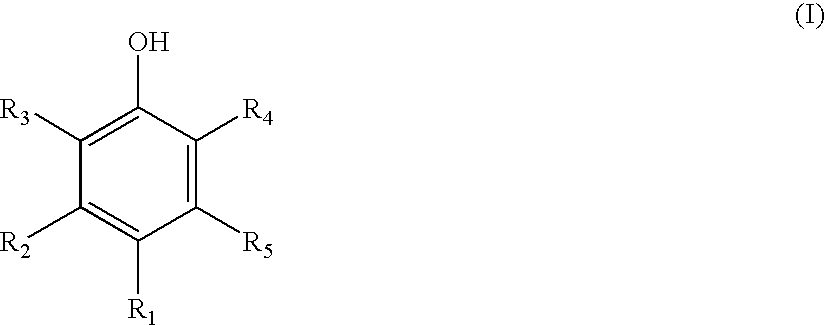Novel additives for imparting Mar and scratch resistance and compositions comprising the same
- Summary
- Abstract
- Description
- Claims
- Application Information
AI Technical Summary
Benefits of technology
Problems solved by technology
Method used
Image
Examples
example 1
[0103]
[0104] A carbinol functional siloxane having Structure VIII was prepared by hydrosilylation. Specifically, 1.2 parts by weight of 1-allyloxy-2-propanol in the presence of a catalytic amount of chloroplatinic acid (10 ppm platinum as a solution of 7.5% by weight in isopropanol) and 0.004 parts by weight of magnesium silicate was warmed to 80° C. under inert atmosphere. One part by weight 1,1,1,3,5,5,5-heptamethyltrisiloxane was added through an addition funnel over 5 hours. The mixture was treated with 0.02 parts by weight of a 35% solution of aqueous hydrogen peroxide and stirred for two hours at 80° C. Filtration yields [3-[1,3,3,3-tetramethyl-1-[(trimethylsilyl)oxy]disiloxanyl]propoxy]-propanol (CAS# [77623-99-5]) as a water white liquid.
example 2
[0105] A mixture of 1 part by weight CYMEL 303 ((methoxymethyl)melamine-formaldehyde from Cytec Industries, Inc.), 0.75 parts by weight 2,4-di-tert-butylphenol and 0.75 parts by weight xylene was heated to 120° C. in the presence of 0.001 parts by weight p-toluenesulfonic acid under inert atmosphere. The reaction vessel was fitted with a distillation head and distillate was collected at a head temperature of 65° C. until there was no visible hydroxyl peak in the infrared spectrum. To the reaction mixture, 0.45 parts by weight of the siloxane prepared according to Example 1 was added and distillate was collected until there was no visible hydroxyl peak in the infrared spectrum. The acid catalyst was neutralized with the addition of 0.0025 parts by weight of sodium carbonate. The reaction mixture was cooled to 80° C. and 3.1 parts by weight of Nissan MEK-ST (30% colloidal silica in methyl ethyl ketone) were mixed in. Solvents were removed under reduced pressure to yield a solid resino...
example 3
[0106] Into a two-liter, four-necked reaction kettle equipped with a thermometer, a mechanic stirrer, a nitrogen inlet, and a separator were placed 955.0 parts by weight of hydrogenated Bisphenol-A, 308.0 parts by weight of hexahydrophthalic anhydride, 1.3 parts by weight of di-butyl tin oxide, and 1.3 parts by weight of triisodecylphosphite. The mixture was melted by heating and was further heated to 230° C. while the water resulting from the reaction was removed through the separator. The reaction was stopped when an acid value of two was achieved. The polyester had a hydroxyl number of 160 and Tg around 65° C.
PUM
| Property | Measurement | Unit |
|---|---|---|
| Temperature | aaaaa | aaaaa |
| Particle size | aaaaa | aaaaa |
| Fraction | aaaaa | aaaaa |
Abstract
Description
Claims
Application Information
 Login to View More
Login to View More - R&D
- Intellectual Property
- Life Sciences
- Materials
- Tech Scout
- Unparalleled Data Quality
- Higher Quality Content
- 60% Fewer Hallucinations
Browse by: Latest US Patents, China's latest patents, Technical Efficacy Thesaurus, Application Domain, Technology Topic, Popular Technical Reports.
© 2025 PatSnap. All rights reserved.Legal|Privacy policy|Modern Slavery Act Transparency Statement|Sitemap|About US| Contact US: help@patsnap.com



